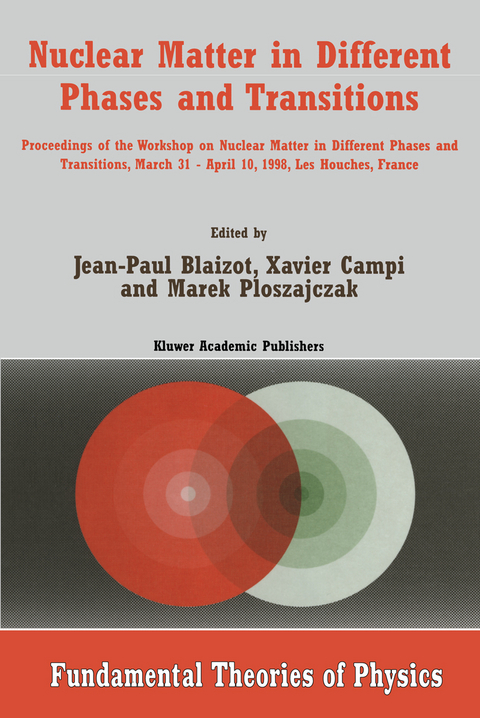
Nuclear Matter in Different Phases and Transitions
Springer (Verlag)
978-94-010-5934-3 (ISBN)
Section I Thermal and chemical equilibrium.- Probing thermalizing nuclear matter with hard photons.- Hadron multiplicities in high energy e+e?, p?p and pp collisions with a statistical - thermal model.- Phase transitions without thermodynamic limit.- The role of statistics and thermodynamics in nuclear multifragmentation.- Hydrodynamic description of very high energy heavy ion collisions.- Section II Non-equilibrium dynamics.- Hadronic transport model with a phase transition.- Baryon transport dynamics : from p — p to Pb — Pb collisions.- Semihard interactions in nuclear collisions based on a unified approach to high energy scattering.- Dynamics of the chiral phase transition.- Filamentation instability in ultrarelativistic heavy-ion collisions.- Section III Phase transitions and the critical behaviour.- Critical behaviour in finite temperature QCD.- Chaos as a signature of quark — hadron phase transition.- Universality of the off-equilibrium critical fragmentation.- Bose-Einstein condensation in trapped atomic gases.- Thermodynamics and cluster content of finite excited systems of classical particles with short and long range interactions.- Percolation approach to the liquid gas phase transition — Isospin degree of freedom.- Critical phenomena in finite systems.- Deuteron versus ?-particle condensation and precritical pair fluctuations in low density nuclear matter.- Section IV Hadronic matter and the quark — gluon plasma.- QCD phases at high density and instantons.- Colour deconfinement in high energy collisions.- The phase transition between the quark-gluon plasma and the hadronic matter : What can we learn from vector mesons?.- Quark gluon plasma in A + A collisions at CERN SPS.- Chemical equilibrium in ultra-relativistic nuclear collisions.- Flowphenomena as possible signals of the QCD phase transition.- Quark-hadron interactions in nuclear matter : Deconfinement signal.- Constraining a simple hadronization model of relativistic heavy-ion collisions using hadronic observables.- Probing chiral symmetry restoration with heavy ions.- Low mass dilepton production at the CERN SPS.- Strangeness and in-medium effects in heavy-ion collisions at SIS energies.- Bose-Einstein condensation in multipion systems.- Determination of emission times using two particle correlation.- Section V Multifragmentation, liquid — gas phase transition.- Boltzmann — Langevin approaches.- Liquid-gas phase transition in finite nuclei within fermionic molecular dynamics.- Multifragmentation — a dynamical or a statistical process?.- Multifragmentation in heavy ion reactions : Dynamical effects and thermalization.- The caloric curve of hot nuclei.- Critical behavior in nuclear multifragmentation : A determination of critical exponents and the scaling function.- Light particle probes of the dynamical evolution of multifragmentation reactions.- Cluster-cluster collisions : Fusion, phase transition and fragmentation phenomena.- On microscopic insights into metal cluster fragmentation.- List of participants.
| Reihe/Serie | Fundamental Theories of Physics ; 95 |
|---|---|
| Zusatzinfo | XII, 532 p. |
| Verlagsort | Dordrecht |
| Sprache | englisch |
| Maße | 160 x 240 mm |
| Themenwelt | Mathematik / Informatik ► Informatik ► Theorie / Studium |
| Naturwissenschaften ► Physik / Astronomie ► Atom- / Kern- / Molekularphysik | |
| Naturwissenschaften ► Physik / Astronomie ► Festkörperphysik | |
| Naturwissenschaften ► Physik / Astronomie ► Thermodynamik | |
| ISBN-10 | 94-010-5934-9 / 9401059349 |
| ISBN-13 | 978-94-010-5934-3 / 9789401059343 |
| Zustand | Neuware |
| Haben Sie eine Frage zum Produkt? |
aus dem Bereich


